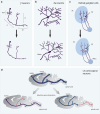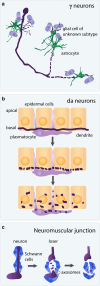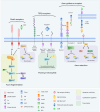Mechanisms of developmental neurite pruning
- PMID: 25213356
- PMCID: PMC5086088
- DOI: 10.1007/s00018-014-1729-6
Mechanisms of developmental neurite pruning
Abstract
The precise wiring of the nervous system is a combined outcome of progressive and regressive events during development. Axon guidance and synapse formation intertwined with cell death and neurite pruning sculpt the mature circuitry. It is now well recognized that pruning of dendrites and axons as means to refine neuronal networks, is a wide spread phenomena required for the normal development of vertebrate and invertebrate nervous systems. Here we will review the arising principles of cellular and molecular mechanisms of neurite pruning. We will discuss these principles in light of studies in multiple neuronal systems, and speculate on potential explanations for the emergence of neurite pruning as a mechanism to sculpt the nervous system.
Figures






References
-
- Thomas JB, Bastiani MJ, Bate M, Goodman CS. From grasshopper to Drosophila: a common plan for neuronal development. Nature. 1984;310(5974):203–207. - PubMed
-
- Tessier-Lavigne M, Placzek M, Lumsden AG, Dodd J, Jessell TM. Chemotropic guidance of developing axons in the mammalian central nervous system. Nature. 1988;336(6201):775–778. - PubMed
-
- Dickson BJ. Molecular mechanisms of axon guidance. Science. 2002;298(5600):1959–1964. - PubMed
Publication types
MeSH terms
Grants and funding
LinkOut - more resources
Full Text Sources
Other Literature Sources

